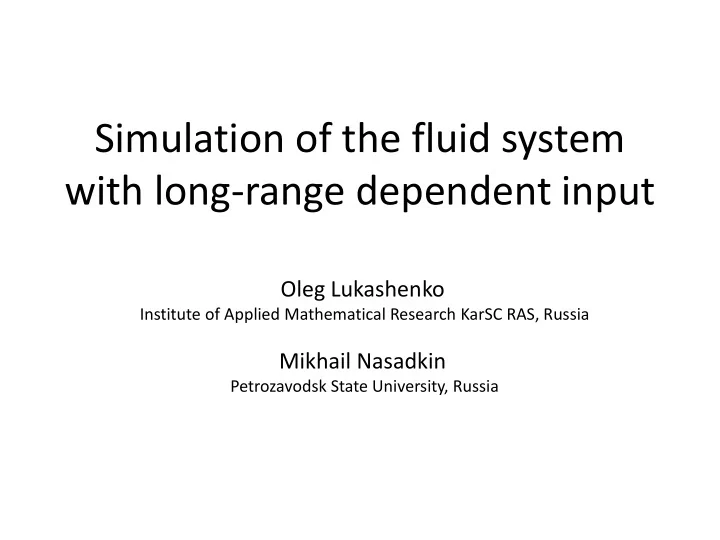

Simulation of the fluid system with long-range dependent input Oleg Lukashenko Institute of Applied Mathematical Research KarSC RAS, Russia Mikhail Nasadkin Petrozavodsk State University, Russia
Gaussian traffic Each source is described by ON/OFF process 1 , t ON period ( m ) ( m ) W W ( t ) ( t ), t 0 , where 0 , t OFF period F x ( x ) ~ , 1 2 ON ON ON x F ( x ) ~ , 1 2 OFF OFF OFF Cumulative traffic of M sources on [0, tT] tT M ( m ) W W ( tT ) ( u ) du m 1 0
Convergence to FBM Interest is in the behavior of this process when M,T are large(Taqqu, 1997). ON W ( tT ) TMt d ON OFF lim lim c B ( t ) , t 0 H H M T T M 3 min( , ) 1 ON OFF H 1 here 2 2 It means that H ON W ( tT ) TMt M T cB ( t ) H ON OFF
System with finite buffer Input : A ( t ) mt am B ( t ) H Service : constant service rate C Stationary overflow probability: sup P ( Q b ) P A ( t ) ct b t 0
System with finite buffer Q ( t ) Q ( t 1 ) c m am B ( t ) B ( t 1 ) b H H Q ( t ) 0 Q ( t ) b Q b ( t ) b Q b ( t ) 0 b Q ( t ) min Q ( t 1 ) C m am B ( t ) B ( t 1 ) , b b H H
System with finite buffer Buffer size 3 Infinite buffer
Overflow and loss probability N I Q b k Overflow probability (N – sample k 1 P ( Q b ) size): N T Q ( t 1 ) m am B ( t ) B ( t 1 ) C b b H H P ( b , T ) k 1 Loss probability on [0,T]: Loss A ( T ) E Q m am B ( t ) B ( t 1 ) C b P ( b ) b H H T Loss m P ( b ) const , b Loss [Kim & Shroff, 2001] P ( Q b ) P ( 0 ) Then Loss P ( b ) P ( Q b ) Loss P ( Q 0 )
Relative error M – number of samples ~ p - estimation of overflow probability Loss ~ p Var ~ Loss 1 p RE ~ , p 0 Loss ~ Loss p M p Loss E Loss It means that number of samples M must be sufficiently large.
Overflow probability – dependence on sample size H=0.9
Overflow probability – theoretical results [Duffield N., O’Connell N.,1995] In the case of fractional Brownian motion input 2 2 H 2 H 1 b C P ( Q b ) exp 2 1 H H
Overflow probability – comparison with theoretical results Simulation H=0.9 Theory H=0.9
Loss probability – dependence on sample size H=0.9
Loss probability – dependence on H
Loss probability – dependence on buffer size
References Asmussen S., Glynn P. Stochastic Simulation: algorithms and analysis. Springer, 2007. Norros I. A storage model with self-similar input, Queuing Systems, vol. 16, pp. 387-396, 1994. Han S. Kim, Ness B. Shroff. On the asymptotic relationship between the overflow probability and the loss ratio, Adv. in Appl. Probab. Volume 33, Number 4 (2001), 836-863. Taqqu M., Willinger W., Sherman R. Proof of a fundamental result in self-similar traffic modeling, Computer Communication Review, 27 (1997) 5-23. Duffield N., O’Connell N. Large deviations and overflow probabilities for general single-server queue, with applications. Math. Proc. Camb. Phil. Soc. 118 (1995), 363 – 374. [ p. 69 ]
Thank you
Recommend
More recommend